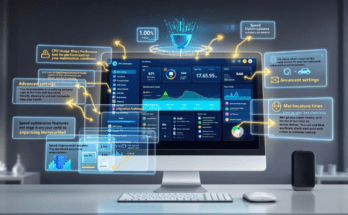Introduction
Technology was not even a big thing in the life of the human being, but now the technology importance is increasing rapidly. Banking, shopping, social networks, cloud storages, and other services are already an inalienable part of our daily experience. Indeed as the use of the internet and related technologies becomes more prevalent especially in doing business, so has the significance of cybersecurity risen significantly.
The frequency of cyber attacks in recent times has become more severe and possible and necessary to take steps in order to keep your online presence safe from hackers, keep your data safe from a breach and a safe online experience for users. With emergence of newer and much more complex threats in the digital world, it becomes imperative to keep abreast of the new developments, threats and security solutions at your disposal.
What is Cybersecurity?
Cyber security therefore means the security of computers, computer networks and software and other related gadgets from attack and vandalism. It can be simply put as creating a shield of digital or cyber security measures that can protect capital assets such as networks, devices and programs from being cyber threat or an intrusion. Information security can be defined as the broader discipline that includes cybersecurity, as the latter is the protection of information and technology in the computer network from malicious cyber operations.
Types of Cyber Threats
That is why there are a huge number of cyber threats that can vary from simple types of viruses and malware to complex ransomware attacks. Here are a few common cybersecurity threats that users should be aware of:
1. Phishing Attacks: Phishing which is a form of fraud aims at forcing a user to reveal top secretes including log-in details and financial information. It is usually in form of an e-mail or Short Message Service text message that leads the user to an ‘urgency’ website looked similar to that of the real site.
2. Malware: Malware simply means a software that is designed with malicious intent on other computers or computing devices. Viruses, worms, Trojan, ransom, and spy are all types of Malwares and all work differently.
3. DDoS Attacks: Its achieve its objective by flooding the target internet network or computer system with traffic as a means of making it inaccessible to users. It is impossible for the target of such an attack to answer legitimate traffic; this causes the website or service to crash.
4. Man-in-the-Middle Attacks: MitM is a type of attack where a mischievous person siphons the information exchange between two parties to oneself. The type of attack can happen in the course of any transaction whether online business or even in interpersonal correspondence via the internet.
How does cyber security relate to needing privacy?
However in the period in which we are living, in which technologies are advancing so much, cyber security has turned into one of the most crucial parts, as it guards confidential information from it, avoids financial loss, provides security for the individual data. CIOs know that a data breach or cyber attack can cost a company major dollar, and its reputation, and expose it to legal risks. Furthermore, cybersecurity is required for business environments to rebuild customer confidence and for personal data protection and safeguarding global infrastructure systems.
For business entities, cybersecurity is important so that they can protect ownership and knowledge assets, customers’ details, and market edge. It also help in continuity of business by protecting it from possible cyber risks that may cause an interruption of its functions.
We present the best practices for cybersecurity as follows
Taking into consideration the growing threat of cyber attacks, the lessons are consistent with the best practice in cybersecurity. Here are a few best practices to help protect against cyber threats:
1. Strong Passwords: You should always use strong and different password for all your online accounts and do not use the same password for all. Use uppercase and lowercase letters, and numbers, symbols, as well as a combination of these three.
2. Multi-factor Authentication: The user’s recommendation would be to turn on two-factor authentication on all accounts that the user has active online. Multi factor authentication asks the user to give another form of identification, like a one time code sent to the accessed mobile device.
3. Regular Software Updates: Almost all software can be regularly updated to minimize risk from known vulnerabilities in the operating system, browser and other software. Cyber criminals use loopholes in outdated software to breach the company’s system.
4. Anti-virus Software: Use and update Reputable Anti virus detection and removal to identify and prevent viruses from finding their way into your devices.
5. Educate Yourself and Others: Learn about todays threat landscape and the available security solutions. Virtually let other people about the things that have been passed down to them so as to make the best practices in cybersecurity.
Conclusion
Finally, it must be emphasized that today we are living in a world, a society that does not accept the absence of the Cybersecurity. Currently, with an high rate of occurrence threats within organizations, it is important to stay updated on the issues and enhance security in the organizations. Knowing the types of threats, having responsible habits, and taking precautions, we will be able to site safely in similar digital worlds. Where businesses and other organizations are going increasingly online, the role of protecting from cyber threats is extremely valuable.



